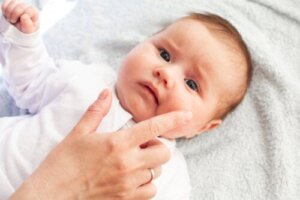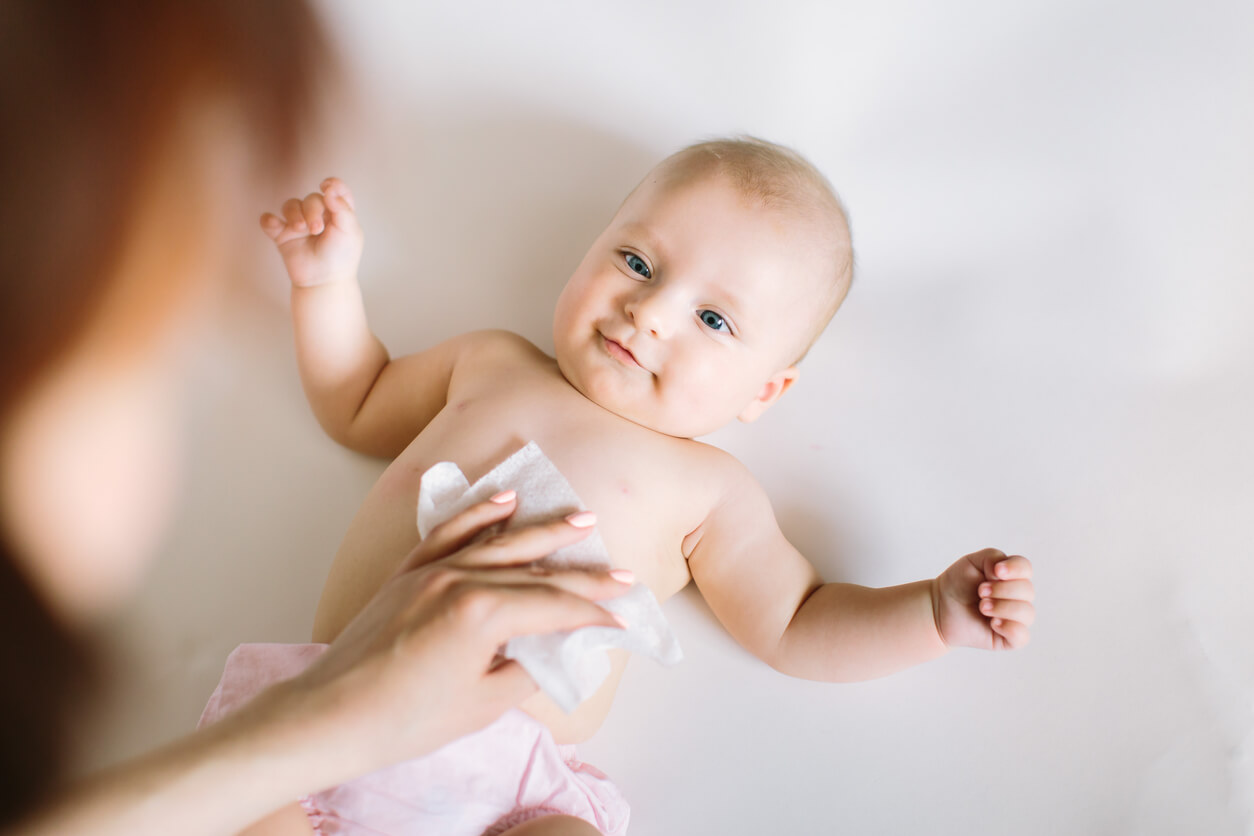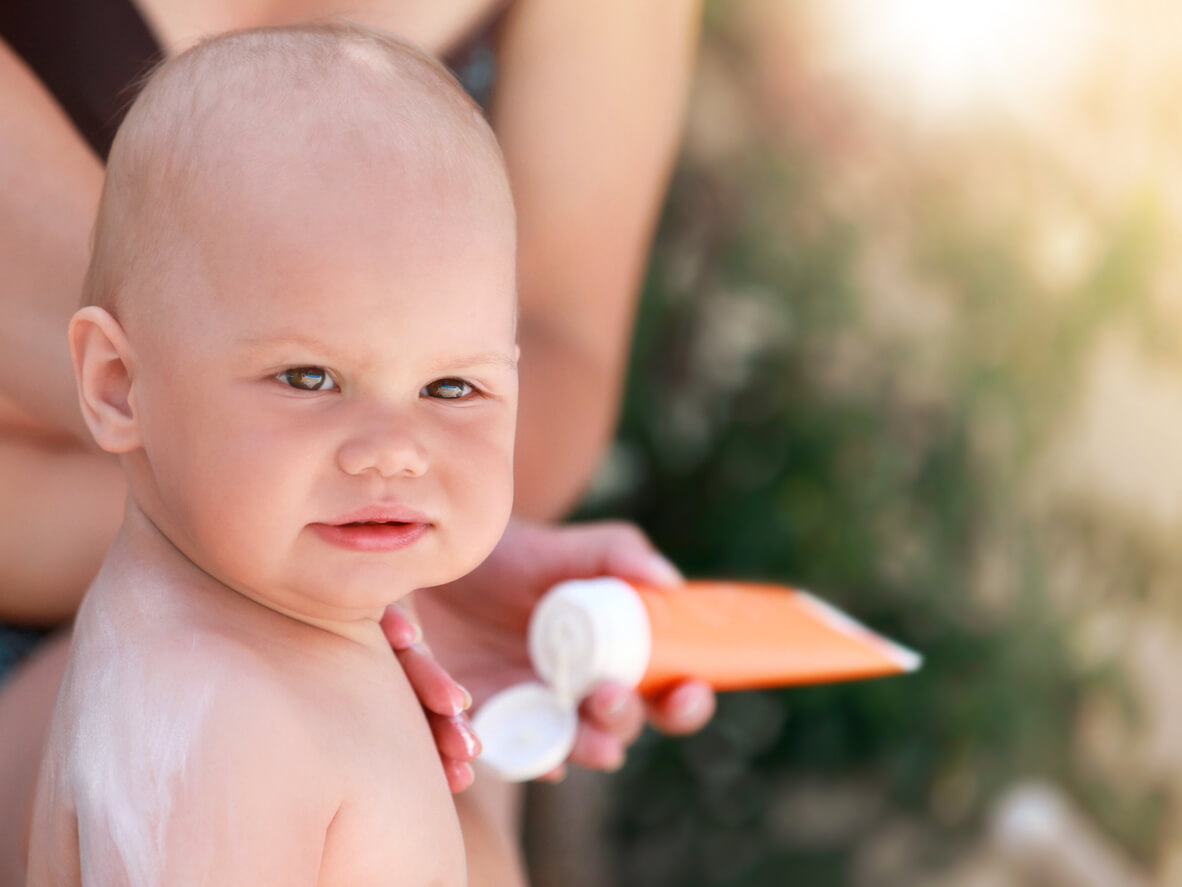Top 10 Baby Skin Irritants


Written and verified by the dermatologist Maria del Carmen Hernandez
There are many skin irritants when it comes to babies. Because it’s not fully developed, their skin is more sensitive and delicate. Therefore, not all products suitable for adults can also be used on children. Here are some of the most common skin irritants.
Learn about the baby skin irritants
The vast majority of cleaning or hygiene products should be formulated appropriately and take into account the particular nature of the characteristics of a baby’s skin.
1. Nickel
Nickel is one of the main causes of irritant reactions in the general population, both in children and adults. In fact, it’s the number one allergen in the frequency of positive reactions to the patch test. Eruptions are characterized by recurrent eczematous lesions in areas of direct contact with the products that release it, such as the wrists, earlobes, neck, and umbilical region.
2. Sweat
Heat dermatitis, also known as miliaria or prickly heat. It’s a heat rash in infants, where excessive sweating obstructs the sweat glands. The clinical manifestations are based on small red bumps or blisters. It doesn’t usually require medical attention and tends to disappear on its own. Clothing that’s too warm or too tight can worsen the condition.
3. Neomycin
Neomycin is one of the most commonly used topical antibiotic preparations found in common over-the-counter products. It should be noted that there’s a high degree of sensitization in infants to this topical drug. In fact, in 2010, the American Contact Dermatitis Society designated it as the allergen of the year.

4. Wet wipes
It’s important to ensure that wet wipes contain ingredients that are gentle and safe for the skin’s surface. This will help minimize skin discomfort and irritation. There are some that are made with fragrances and products that act as skin irritants in the case of babies.
You may be interested in: 7 Things You Didn’t Know About Babies’ Skin
5. Saliva
Drooling may occur in healthy babies under 2 years of age. However, it’s most prominent around five to six months of age, when salivation increases to its maximum capacity. To avoid the irritation that saliva often causes in the perioral region, the use of petroleum jelly or other products is recommended before the baby sleeps or eats, which is when saliva accumulates.
6. Perfumes
All cosmetic products intended for babies should be free of some potential skin irritants such as the following:
- Alcohol
- Essential oils
- Strong detergents
- Fragrances
- Soap
In addition, fragrances shouldn’t be applied to the baby’s delicate skin, but rather sprayed onto clothing so that it doesn’t come into direct contact.
7. Fecal matter
Diaper rash dermatitis is a complicated skin condition characterized by compromised barrier function. It occurs on the perianal region, buttocks, abdomen, and inner thighs. The proteolytic and lipolytic activity of fecal enzymes along with skin occlusion, friction, and increased pH are factors that aid in the development of irritant dermatitis.
Read also: My Baby Has Reactive Skin
8. Detergents
There are harsh detergents that contain SLS (sodium lauryl sulfate) and can be irritating to babies’ skin. Some of the products that contain SLS may include the following:
- Bath oils
- Baby soap
- Babyconditioner
- Baby shampoo
Certain laundry detergents can cause allergies or sensitivity in babies due to their high content of fragrances and colorants. Consequently, the manifestations appear in the areas of the skin that come into contact with the allergen.

9. Sunscreens
Some sunscreens are more suitable for babies because of their low capacity to produce allergic reactions. This product should be broad spectrum, i.e., protect against UVA and UVB rays.
In turn, to prevent rashes, it’s ideal to choose those that are composed of zinc oxide and titanium dioxide. These are hypoallergenic compounds that, when applied to the skin, aren’t absorbed like chemical sunscreens.
10. Antibacterial soap
70% of antibacterial soaps contain triclosan, which is a non-recommended ingredient that eliminates germs from the skin surface. However, plain soap and water are advised to fulfill this role. In 2013, the Food and Drug Administration (FDA) asked manufacturers to submit data demonstrating the long-term efficacy and safety of such products.
Skin irritants and babies
The skin of babies lacks the necessary maturation of its outermost layers. For this reason, it’s very vulnerable to certain care, hygiene, or cosmetic products. Ideally, it’s best to read the labels of all products and choose those that are suitable for use on babies. In other words, those that are hypoallergenic and free of parabens and phthalates.
There are many skin irritants when it comes to babies. Because it’s not fully developed, their skin is more sensitive and delicate. Therefore, not all products suitable for adults can also be used on children. Here are some of the most common skin irritants.
Learn about the baby skin irritants
The vast majority of cleaning or hygiene products should be formulated appropriately and take into account the particular nature of the characteristics of a baby’s skin.
1. Nickel
Nickel is one of the main causes of irritant reactions in the general population, both in children and adults. In fact, it’s the number one allergen in the frequency of positive reactions to the patch test. Eruptions are characterized by recurrent eczematous lesions in areas of direct contact with the products that release it, such as the wrists, earlobes, neck, and umbilical region.
2. Sweat
Heat dermatitis, also known as miliaria or prickly heat. It’s a heat rash in infants, where excessive sweating obstructs the sweat glands. The clinical manifestations are based on small red bumps or blisters. It doesn’t usually require medical attention and tends to disappear on its own. Clothing that’s too warm or too tight can worsen the condition.
3. Neomycin
Neomycin is one of the most commonly used topical antibiotic preparations found in common over-the-counter products. It should be noted that there’s a high degree of sensitization in infants to this topical drug. In fact, in 2010, the American Contact Dermatitis Society designated it as the allergen of the year.

4. Wet wipes
It’s important to ensure that wet wipes contain ingredients that are gentle and safe for the skin’s surface. This will help minimize skin discomfort and irritation. There are some that are made with fragrances and products that act as skin irritants in the case of babies.
You may be interested in: 7 Things You Didn’t Know About Babies’ Skin
5. Saliva
Drooling may occur in healthy babies under 2 years of age. However, it’s most prominent around five to six months of age, when salivation increases to its maximum capacity. To avoid the irritation that saliva often causes in the perioral region, the use of petroleum jelly or other products is recommended before the baby sleeps or eats, which is when saliva accumulates.
6. Perfumes
All cosmetic products intended for babies should be free of some potential skin irritants such as the following:
- Alcohol
- Essential oils
- Strong detergents
- Fragrances
- Soap
In addition, fragrances shouldn’t be applied to the baby’s delicate skin, but rather sprayed onto clothing so that it doesn’t come into direct contact.
7. Fecal matter
Diaper rash dermatitis is a complicated skin condition characterized by compromised barrier function. It occurs on the perianal region, buttocks, abdomen, and inner thighs. The proteolytic and lipolytic activity of fecal enzymes along with skin occlusion, friction, and increased pH are factors that aid in the development of irritant dermatitis.
Read also: My Baby Has Reactive Skin
8. Detergents
There are harsh detergents that contain SLS (sodium lauryl sulfate) and can be irritating to babies’ skin. Some of the products that contain SLS may include the following:
- Bath oils
- Baby soap
- Babyconditioner
- Baby shampoo
Certain laundry detergents can cause allergies or sensitivity in babies due to their high content of fragrances and colorants. Consequently, the manifestations appear in the areas of the skin that come into contact with the allergen.

9. Sunscreens
Some sunscreens are more suitable for babies because of their low capacity to produce allergic reactions. This product should be broad spectrum, i.e., protect against UVA and UVB rays.
In turn, to prevent rashes, it’s ideal to choose those that are composed of zinc oxide and titanium dioxide. These are hypoallergenic compounds that, when applied to the skin, aren’t absorbed like chemical sunscreens.
10. Antibacterial soap
70% of antibacterial soaps contain triclosan, which is a non-recommended ingredient that eliminates germs from the skin surface. However, plain soap and water are advised to fulfill this role. In 2013, the Food and Drug Administration (FDA) asked manufacturers to submit data demonstrating the long-term efficacy and safety of such products.
Skin irritants and babies
The skin of babies lacks the necessary maturation of its outermost layers. For this reason, it’s very vulnerable to certain care, hygiene, or cosmetic products. Ideally, it’s best to read the labels of all products and choose those that are suitable for use on babies. In other words, those that are hypoallergenic and free of parabens and phthalates.
All cited sources were thoroughly reviewed by our team to ensure their quality, reliability, currency, and validity. The bibliography of this article was considered reliable and of academic or scientific accuracy.
- Adalat S, Wall D, Goodyear H. Diaper dermatitis-frequency and contributory factors in hospital attending children. Pediatr Dermatol. 2007 Sep-Oct;24(5):483-8. doi: 10.1111/j.1525-1470.2007.00499.x. PMID: 17958792. https://pubmed.ncbi.nlm.nih.gov/17958792/
- Morelli JG, Weston WL. What sunscreen should I use for my 3-month-old baby? Pediatrics. 1993 Dec;92(6):882. PMID: 8233760. https://pubmed.ncbi.nlm.nih.gov/8233760/
- Ley C, Sundaram V, Sánchez ML, Desai M, Parsonnet J. Exposición al triclosán y triclocarbán, síntomas de enfermedades infecciosas y prescripción de antibióticos en lactantes: una intervención aleatorizada comunitaria. PLoS One . 2018; 13 (6): e0199298. Publicado el 28 de junio de 2018. doi: 10.1371 / journal.pone.0199298
This text is provided for informational purposes only and does not replace consultation with a professional. If in doubt, consult your specialist.








